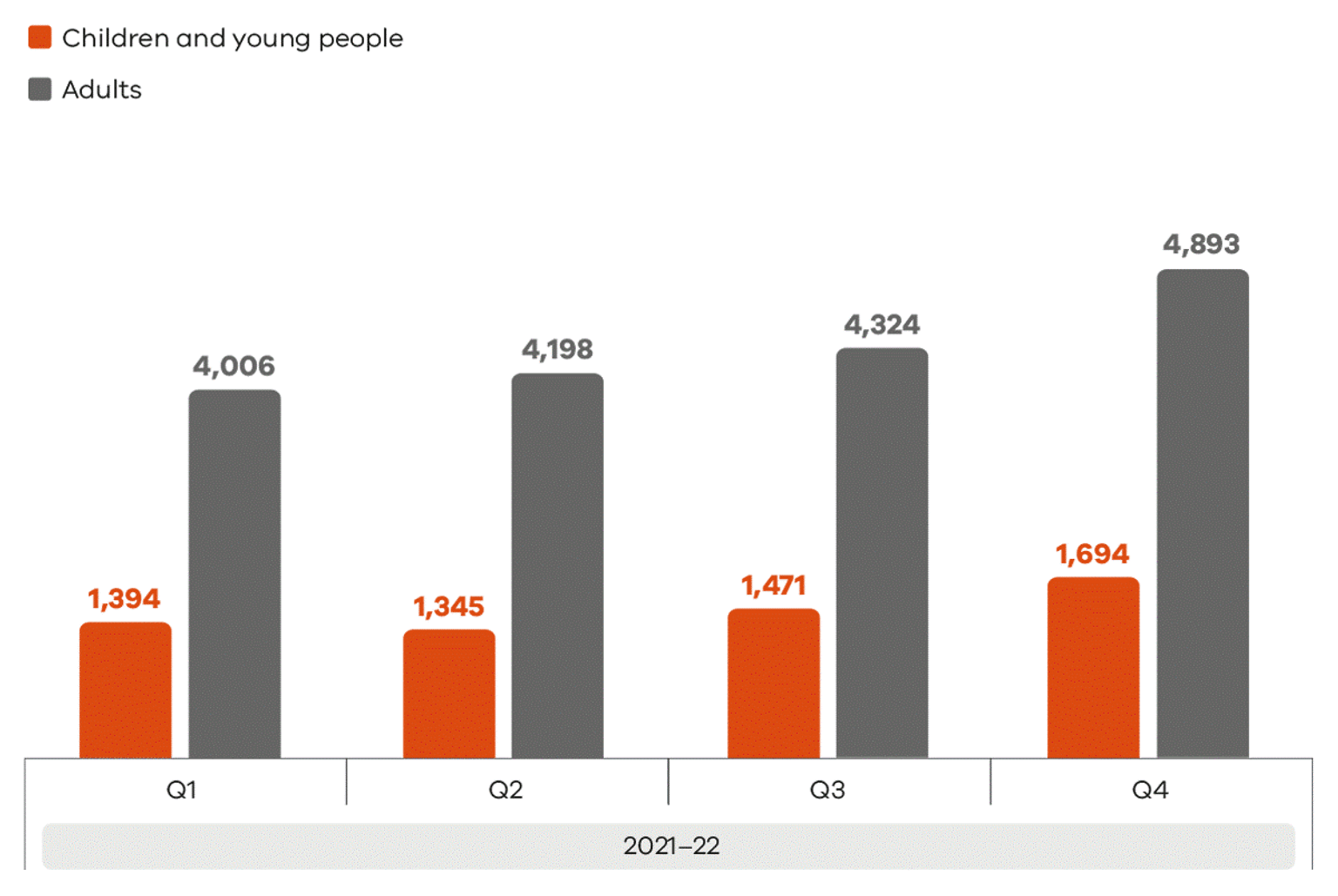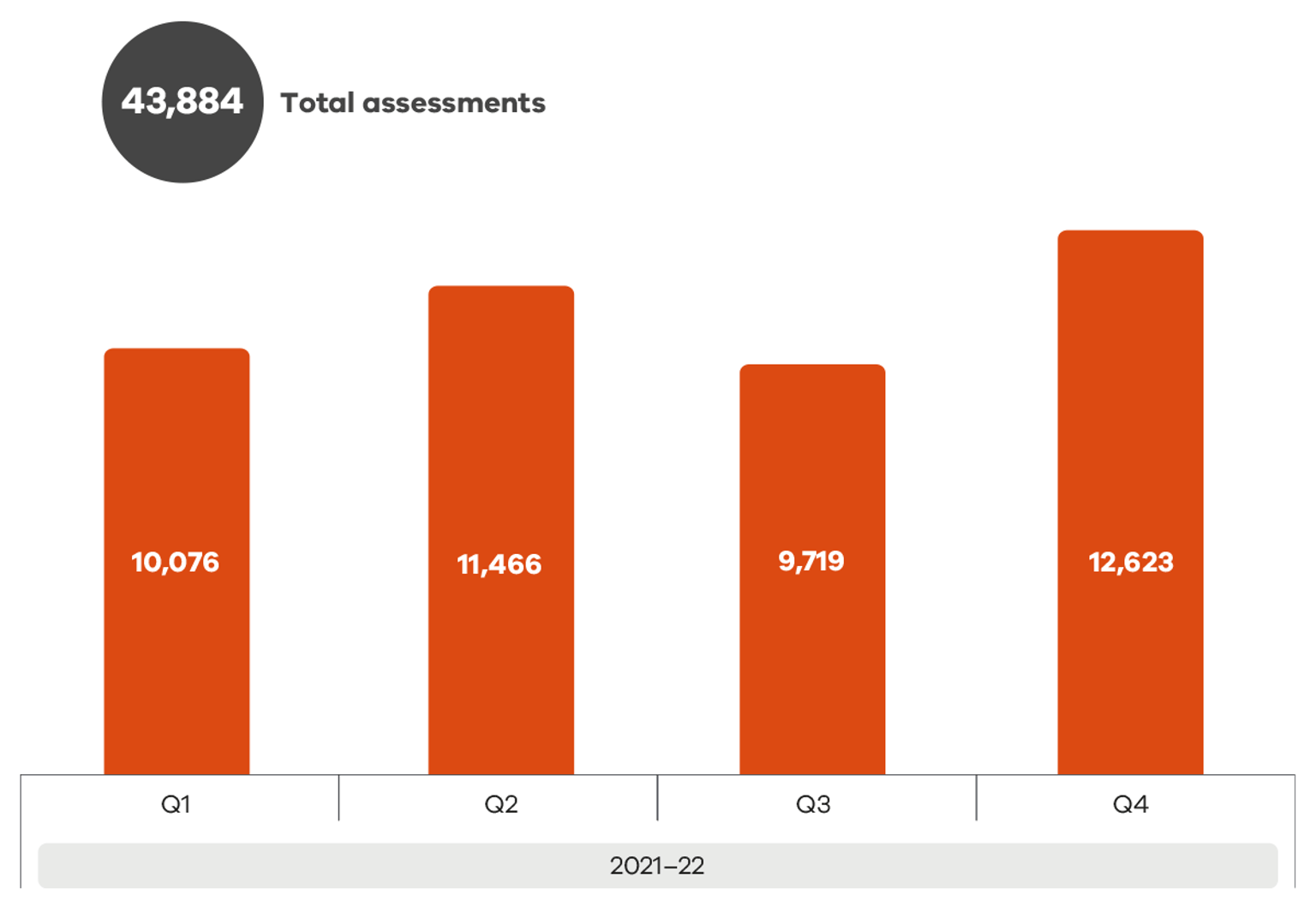How is The Orange Door network working with people to identify risk and prioritise their needs?
Practitioners at The Orange Door network are supported to do their work by changes to information sharing legislation, an improved family violence risk assessment and management framework, the Central Information Point and working within interdisciplinary teams. The Orange Door network takes a person-centred approach to working with families by identifying service responses based on risk and need, including family violence, and safety and support of children and young people. In the process of supporting a family, children and young people are treated as individuals and as victims in their own right where they have experienced family violence.
Once a referral is received, priority and urgency of response is determined through the screening, intake and triage process, where an initial assessment is undertaken based on the information in the referral, the referral history at The Orange Door and any past engagement with partner agencies. The referral will then move onto the assessment and planning stage where the practitioners will engage with the individual/family to assess the key risks and needs of each individual and to identify their goals and preferences in the context of their family and community.
The Orange Door network also works closely with Risk Assessment and Management Panels (RAMPs) to ensure that high risk situations are managed in the best possible way.[17] RAMPs are responsible for developing and implementing multi-agency action plans for individual high-risk cases. This lessens or prevents serious threats to children, young people and women, and increases perpetrator accountability. RAMPs receive referrals from services which are working with women or families where there are concerns that there is a high risk of harm that is not adequately mitigated by the current range of interventions. 18 RAMPs currently operate across Victoria.
Assessing risk where family violence is present
Practitioners within The Orange Door network assess the family violence risk that perpetrators pose for victim survivors. Practitioners work across specialisations to ensure there is an interdisciplinary response to address identified risk and needs and to develop appropriate risk management strategies, including safety planning. The process of assessing family risk is ongoing throughout the time that The Orange Door network works with a client.
The Family Violence Multi-Agency Risk Assessment and Management (MARAM) Framework supports professionals to effectively identify, assess and manage family violence risk. The MARAM Framework together with the Family Violence Information Sharing Scheme (FVISS) strengthens system-wide family violence risk assessment and management, and facilitates better sharing of risk-relevant information between services. This helps keep people safe and perpetrators in view.
In addition, the Child Information Sharing Scheme (CISS), supports professionals in sharing information to promote the safety and wellbeing of children and young people (child safety and wellbeing assessment is explored in a separate section below).
In 2021-22, practitioners undertook more than 23,000 family violence risk assessments.[18] Of these, more than 17,000 assessments were undertaken for adults and nearly 6,000 were undertaken for children and young people (Figure 11).
The number of assessments undertaken by practitioners increased by 102.6%, compared to 2020-21. While the increase in risk assessments is mostly due to the commencement of the seven new The Orange Door areas in 2021-22, as well as the first complete year of operations for three others, five initial The Orange Door areas also showed an increase of 12.4%.
The number of risk assessments undertaken in 2021-22 was lower than the number of people who were provided with a response. This reflects the fact that The Orange Door network is sometimes unable to contact the person referred (20.7% in 2021-22), or when they do the person chooses not to take up the offer of a service or support (21.0% in 2021-22). These proportions include referrals for perpetrators of family violence who more frequently do not respond to attempts to contact or decline the offer of services. In a small number of cases, a decision may be made not to make contact with a perpetrator as it would significantly increase risk for a victim-survivor.
The practice of recording family violence risk assessments is improving across The Orange Door network. Nonetheless, it continues to be an area for further improvement and development.
Sam and Tony: assessing and managing serious risk posed by perpetrators[19]
Sam and Tony were referred to The Orange Door network after Victoria Police attended a family violence incident at their home. A Family Violence Intervention Order was in place at the time to protect Sam.
When The Orange Door network received the referral, Sam and Tony were assigned different practitioners who worked in the same integrated team, sharing risk information and the risk assessments. The practitioners also consulted with Practice Leadership to support their assessments and decision-making.
Sam’s family violence practitioner organised to meet Sam at a safe place, where she explained she had returned to the on-and-off three year relationship because she had nowhere else to go. Tony had disclosed multiple attempts at suicide to Sam and had previously been under psychiatric care. Tony also regularly abused a range of prescribed and non-prescribed drugs. Sam disclosed that Tony’s violence had escalated over the last six months, and the violence had increased after she became pregnant. Sam also expressed concerns that Tony was tracking her phone and monitoring her whereabouts.
Tony’s practitioner identified through shared information that Tony had a pattern of perpetrating family violence over 20 years. He had also breached the Family Violence Intervention Order that protected Sam numerous times. Sam was assessed as being at serious risk, requiring immediate protection.
The two practitioners coordinated an integrated response that prioritised the safety of Sam and her unborn child, as well as addressing the needs of Tony. The Orange Door organised Sam safe accommodation and allocated case management. The Orange Door network also advocated for Sam to receive extensive safety planning and service support to transition into long-term accommodation.
The Orange Door practitioners collaborated with Victoria Police, as Tony had been assigned to the Family Violence Investigation Unit and a warrant was issued for breaches of the intervention order. Risk assessments were shared with police. After Tony was arrested and remanded into custody, practitioners collaborated with custodial staff to advocate for Tony’s mental health, as well as priority assessment for substance abuse.
Tony undertook a behaviour change intervention whilst in prison and received support for his mental health and drug and alcohol use. Sam received accommodation support and enhanced maternal health care. Extensive safety planning across agencies was put in place to mitigate harm to Sam upon Tony’s release from prison.
Safety planning
For people experiencing family violence, safety planning is a key part of risk management that is undertaken by The Orange Door network as an immediate support intervention. It typically involves a plan developed by a practitioner with the victim survivor to help manage their own safety in the short to medium term.
In 2021-22, practitioners in The Orange Door network recorded 15,782 safety plans in the CRM to help keep victims of family violence safe, an 84.9% increase from 2020-21. While the increase is largely due to new The Orange Door areas completing plans online, five initial The Orange Door areas also observed a significant increase (31.8%) in the number of safety plans being completed online in the CRM.
Central Information Point
The Central Information Point (CIP) commenced in 2018 and is a unique initiative that helps to keep perpetrators in view. The CIP consolidates critical information relevant to family violence risk from Victoria Police, Corrections Victoria, the Magistrates’ Court of Victoria, and the Department of Families, Fairness and Housing. Information from these sources about a perpetrator or alleged perpetrator is consolidated into a single report for The Orange Door network practitioners to assist with family violence risk assessment and management. In 2021-22, a total of 4,402 CIP reports were provided to practitioners in The Orange Door network.
The rollout of the CIP to RAMPs
The expansion of the CIP to RAMPs was undertaken as a phased rollout from 2020 with rollout completed to all RAMP Coordinators within the 2021-22 financial year. RAMP access to the CIP is part of the Royal Commission into Family Violence recommendation to establish the CIP (Recommendation 7). This Recommendation has now been acquitted with the CIP rollout to RAMPs completed by 30 June 2022, and a rollout schedule in place to support Safe Steps and the Men’s Referral Service access to the CIP in 2022-23.
As part of the expansion of the CIP to RAMPs, training, guidance and other change management materials was provided to ensure RAMPs can access and use the CIP. This supported RAMPs to understand how to request, receive and use information from the CIP for the assessment and management of family violence risk.
Identifying risk and need for children and young people
The Orange Door network practitioners undertake assessments for infants, children and young people where there are concerns for the safety, wellbeing or development of a child, including when they have been impacted by family violence. There is a strong focus on working with families to identify and develop a plan to address safety and wellbeing concerns for children and young people in accordance with the Best Interests Case Practice Model. Community-based Senior Child Protection Practitioners support this process by providing access to information about current or previous identified risk assessments and interventions from Child Protection.
The victim survivor-focused MARAM Practice Guides and tools provide additional guidance to support practitioners to identify, assess and manage family violence risk to children and young people as victim survivors in their own right.
Work is currently underway to update and strengthen the guidance provided under the Best Interests Case Practice Model and the MARAM Framework to support direct engagement with children and young people. This includes when responding to young people using family violence, in the home, in family relationships or within their early intimate relationships.
The Centre for Excellence in Child and Family Welfare has been engaged to provide The Orange Door network practitioners with resources and skills to identify and prioritise what is in the child’s best interests, to work directly with children and young people in ways that promote their participation in the decision-making and processes that affect them, as well as making sure they are safe and able to thrive.
In 2021-22 practitioners undertook nearly 44,000 child safety, wellbeing and other assessments (Figure 12).[20] As with family violence risk assessments, the increase in the number of child safety, wellbeing and other assessments was largely due to commencement of seven new The Orange Door areas. However, there was also improvement in the number of assessments across the five initial The Orange Door areas, with an increase of 15% since 2020-21.
Notes
[17] A Risk Assessment and Management Panel or RAMP is a formally convened meeting, held at a local level, of nine key agencies and organisations that contribute to the safety of women and children and young people experiencing serious risk from family violence. Across Victoria, each RAMP meets once a month to share information and take action to keep women and children and young people at the highest risk from family violence safe.
[18] The number of risk assessments reported in Budget Paper 3 reporting for 2021-22 was 23,324. This variation is due to point in time data extraction within a dynamic CRM system.
[19] Names and identifying features of the people involved in this case study have been changed.
[20] 44,156 child safety, wellbeing and needs assessments were reported for 2021-22 in Budget Paper 3 reporting. This variation is due to point in time data extraction within a dynamic CRM system.
Updated

